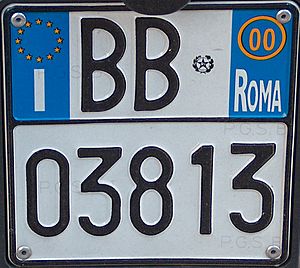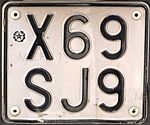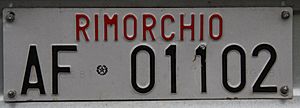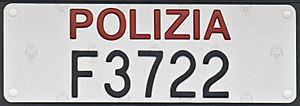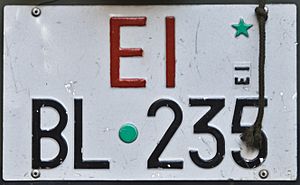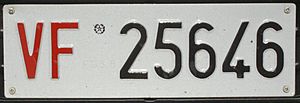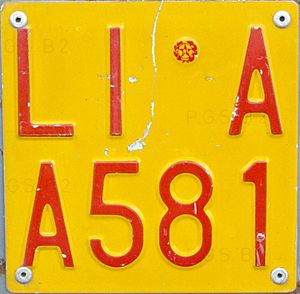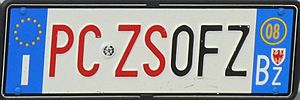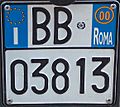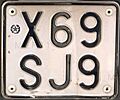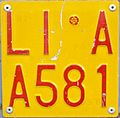Vehicle registration plates of Italy facts for kids
Italian car number plates are special signs on vehicles that help identify them. They have black letters and numbers on a white background. Like many plates in Europe, they have small blue sections on the sides. The way numbers are given out since 1994 doesn't tell you where the car is from in Italy. Only one special government office, the Istituto Poligrafico e Zecca dello Stato, is allowed to make these plates. Local government offices then give them out.
Contents
How Italian Car Plates Have Changed
Early Days: 1897–1905
The very first Italian car plates, from 1897 to 1901, had to show the owner's name and a local town number.
Then, from 1901 to 1905, the plates showed the full name of the city where the car came from, followed by a number. For example, you might see GENOVA 83 or PADOVA 2. These were the first metal plates, and car owners had to make them themselves! Today, only two of these old plates still exist in museums.
| GENOVA 83 |
Black on White: 1905–1927
During this time, plates had black numbers on a white background. Each province (like a state or region) had its own special number code, which was written in red. Then, a unique number for that province followed in black. For example, 63 – 2993 meant the car was from Turin (code 63). Front plates were not always required.
| 63 – 2993 |
White on Black: 1927–1976
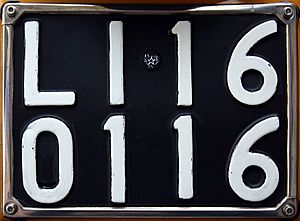
In 1927, the plates changed to white numbers on a black background. They also started using two-letter codes for all provinces, like "LI" for Livorno. The only exception was Rome, which used its full name, ROMA, on the plate.
From 1927 to 1932, the numbers came before the province code. After 1932, the numbers were before the code on front plates, but after it on back plates. Even though Rome used "ROMA" on plates, its unofficial code "RM" was used in documents.
From 1932 to 1951, rear plates were square. They also had symbols next to the province code. First, it was the Fasces emblem (1928-1944). After that, a symbol from a war veterans' group appeared (1944-1948). When Italy became a Republic in 1948, the Republic's emblem (a star with "RI") was added to both front and rear plates.
From 1951 to 1976, rear plates became a bit smaller. Front plates also changed to have straighter letters and a smaller Republic emblem. The numbers on the plates were unique for each province and could be up to six characters long.
| LI 16 0116 |
Front plate example:
| 160116 LI |
Changing Designs: 1976–1994
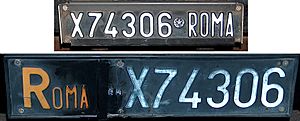
The front plates stayed the same as before. However, rear plates were now made in two parts. One part had the main numbers in white on black. The other part had the province code in orange on black. These two pieces were put together, either side-by-side for rectangular plates or one above the other for square plates. This made it easier for foreign cars to use Italian plates.
In 1985, plates started using black numbers on a white background that reflected light. Front plates became bigger. The numbers on the plates were now placed after the province code, just like on the rear plates. This new system also meant that if a province had fewer than six digits in its number, zeros were added to fill the space (e.g., LC 004239).
| VR A58322 |
Modern Italian Car Plates: 1994–Present

Since February 28, 1994, Italy uses a completely new system. Car plates no longer show where the car comes from directly. Instead, they use a mix of letters and numbers like AA 999 AA. The letters can be any letter except I, O, Q, U. The numbers change first, then the letters from right to left. So, the first plate was AA 000 AA, then AA 001 AA, and so on.
Rear plates are no longer in two pieces. You can choose a square plate for cars that need it. Square plates have a different numbering system, starting with ZA 000 AA.

In 1999, the plates were updated again, starting with BB 000HH. The numbers became thicker. A blue band was added to the left side, showing the European flag (12 yellow stars) and Italy's country code "I". Another blue band was added to the right side. This band can optionally show a yellow circle with the year the car was registered and the two-letter provincial code.
The provincial code was brought back because many people missed it. However, it's not a required part of the number anymore. The main number is unique for the whole country.
|
1994–1999 plate | |||||||
|
|
Current plate from Bolzano | |||||||
|
Square plate from Milan | |||||||
Special Plates in Italy
Motorcycle Plates
Since 1999, motorcycles have plates with two letters and five numbers, starting from AA 00000. These plates also have the blue European band on the left. On the right, there's an optional blue band with the year of registration and the province code.
Older motorcycle plates (1927-1994) used the province code, similar to cars.
|
||||||
Moped Plates
Before 1994, small mopeds didn't have plates. From 1994 to 2006, they had trapezoid-shaped plates with a mix of letters and numbers. In 2006, new rectangular moped plates were introduced. These new plates are linked to the moped itself, not just the owner.
Trailer Plates
Car and truck trailers used to have two plates: a small one for the trailer itself and a yellow one that repeated the main vehicle's number. Since February 2013, new trailer plates look like regular car plates but start with "XL". This means they don't need the extra repetition plate anymore.
Trailer plate example (2013)
Police Plates
Local police vehicles have "POLIZIA LOCALE" (local police) in blue. National police plates have "POLIZIA" in red, followed by letters and numbers. Customs police plates start with "GdiF" in red.
Diplomatic Plates
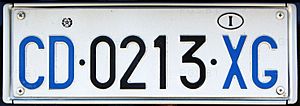
Diplomatic plates have blue letters. They start with "CC" for Consular Corps, "CD" for Diplomatic Corps, or "UN" for United Nations. They also have a country code. These plates are the same size for both front and rear.
|
Current diplomatic plate, XG is for Vatican City. | |
|
United Nations plate for specialists |
Military Plates
Military plates have red prefixes: "EI" for the Army, "AM" for the Air Force, and "MM" for the Navy. They have a special code with letters and numbers. Historical military vehicles use "EI VS 000" with "VS" in green.
|
Current Italian Army plate | |
|
Current Italian Navy plate |
Red Cross Plates
Red Cross plates have the prefix "CRI" (Croce Rossa Italiana) in red. They also have the Red Cross symbol. The numbers and letters are on a white reflective background.
|
Current plate | |
|
Current trailer plate |
Firefighter Plates
Firefighter vehicles have the prefix "VF" (Vigili del Fuoco) in red. Firefighters in special regions like Trento or Bolzano have their own local plates.
|
National firefighter plate | |
|
Firefighter plate from Trento |
Temporary Plates
Temporary plates are used for vehicles that are in Italy for a short time and will be exported. They start with "EE" which means "Foreign Hikers" or "temporary plates". They have a space for a sticker showing the expiry date.
Temporary plate example
| EE 053 AM |
Agricultural Plates
Agricultural machines have yellow plates with black letters and numbers. They are about the size of motorcycle plates. Agricultural trailers have "RIM AGR." (trailer agricultural) in red on their yellow plates.
Agricultural plate example
| AA 1 53C |
Road Machinery Plates
These plates are square, with red letters on a yellow background. They were introduced in 1992.
Current road machinery plate
| AE J 134 |
Civil Defence Plates
These plates are mainly found in Italy's special autonomous regions. They have the prefix "PC" (Protezione Civile) in red. National Civil Defence vehicles use "DPC" (Dipartimento della Protezione Civile).
|
|
Civil Defence plate from Bolzano |
Carabinieri Plates
The Carabinieri, Italy's military police, have plates with the prefix "CC" (Corpo di Carabinieri) in red. They became an independent force in 2000.
Carabinieri plate example
| CC DF 948 |
Test Plates
Test plates are used by car dealers to test cars on public roads, especially if a car doesn't have insurance or a regular plate yet. They are square and have a "P" (for Prova, meaning "Test") instead of the Republic emblem. The owner can choose the code on these plates.
Current Test plate
| X0P 1 AZ3A |
Italian Province Codes
Province Codes Used Since 1927
These two-letter codes are used for Italian provinces and appear on many documents, not just car plates. For example, "Trino (VC)" means the town of Trino in the province of Vercelli. Sometimes, "RM" is used instead of "Roma" for the province of Rome in addresses.
Old Province Codes: 1905–1927
| Number | Province | Number | Province | Number | Province | Number | Province |
|---|---|---|---|---|---|---|---|
| 1 | Alessandria | 2 | Ancona | 3 | L'Aquila | 4 | Arezzo |
| 5 | Ascoli Piceno | 6 | Avellino | 7 | Bari | 8 | Belluno |
| 9 | Benevento | 10 | Bergamo | 11 | Bologna | 12 | Brescia |
| 13 | Cagliari | 14 | Caltanissetta | 15 | Campobasso | 16 | Caserta |
| 17 | Catania | 18 | Catanzaro | 19 | Chieti | 20 | Como |
| 21 | Cosenza | 22 | Cremona | 23 | Cuneo | 24 | Ferrara |
| 25 | Florence (Firenze) | 26 | Foggia | 27 | Forlì | 28 | Genoa (Genova) |
| 29 | Agrigento | 30 | Grosseto | 31 | Lecce | 32 | Leghorn (Livorno) |
| 33 | Lucca | 34 | Macerata | 35 | Mantua (Mantova) | 36 | Massa and Carrara |
| 37 | Messina | 38 | Milan (Milano) | 39 | Modena | 40 | Naples (Napoli) |
| 41 | Novara | 42 | Padua (Padova) | 43 | Palermo | 44 | Parma |
| 45 | Pavia | 46 | Perugia | 47 | Pesaro | 48 | Piacenza |
| 49 | Pisa | 50 | Imperia | 51 | Potenza | 52 | Ravenna |
| 53 | Reggio di Calabria | 54 | Reggio nell'Emilia | 55 | Rome (Roma) | 56 | Rovigo |
| 57 | Salerno | 58 | Sassari | 59 | Siena | 60 | Syracuse (Siracusa) |
| 61 | Sondrio | 62 | Teramo | 63 | Turin (Torino) | 64 | Trapani |
| 65 | Treviso | 66 | Udine | 67 | Venice (Venezia) | 68 | Verona |
| 69 | Vicenza | 70 | Pola | 71 | La Spezia | 72 | Taranto |
| 73 | Trent (Trento) | 74 | Trieste | 75 | Zara | 76 | Fiume |
Diplomatic Codes
These codes are used on diplomatic plates to show which country or organization the vehicle belongs to.
Images for kids
-
Italian vehicle rear number plate used from 1951 to 1976, LI is the provincial code of Livorno.
-
1976-1985 front and rear Italian car number plates. ROMA is the provincial code of Rome.
-
1985-1994 Italian rear car number plate. VR is the provincial code of Verona.
-
1994-1999 Italian rear number plate.
AE 000 HJ to AE 999 HJ belongs to the province of Como -
1999-present Italian vehicle number plate from Bolzano.
-
Current Registration Plate of Corpo Diplomatico from Vatican City (XG) since 1995
See also
 In Spanish: Matrículas automovilísticas de Italia para niños
In Spanish: Matrículas automovilísticas de Italia para niños



